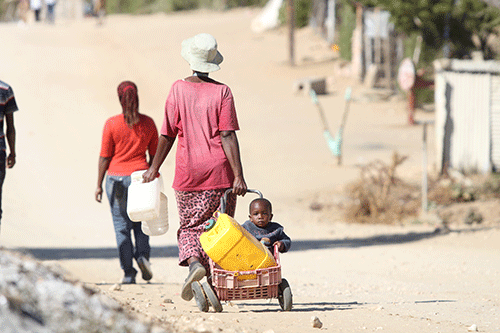The health ministry yesterday announced the end of the Hepatitis E outbreak in Namibia after it was declared a plague in 2017 by the health authorities. However, the ministry confirmed three cases of typhoid fever in Windhoek.
Hepatitis E cases have significantly dropped in all regions since the last quarter of 2020, with only a few cases reported in Windhoek, Walvis Bay and the Okahao districts.
Health minister Dr Kalumbi Shangula said the acute phase of a virus outbreak is defined by the propagation of the virus within communities through the transmission of the virus from one person to another.
“This phase is considered to have been interrupted when no confirmed cases were detected for 20 weeks, or two times the maximum incubation period for Hepatitis E infections, following the last potential exposure to the last case,” said Shangula.
He was speaking at a press conference announcing the confirmation of typhoid fever cases in the Goreangab location in Windhoek, and the end of the Hepatitis E outbreak in the country.
By 4 February 2022, a total of 8 092 Hepatitis E cases were reported, of which 2 124 or 26.2% were laboratory-confirmed, and 4 738 or 58.6% were epidemiologically linked to the confirmed cases.
A total of 1 230 cases or 15.2% were classified as suspected cases. A total number of 2 435 specimens tested negative for Hepatitis E, and were therefore discarded.
“A total of 66 Hepatitis E deaths were recorded nationally, with a case fatality rate (CFR) of 0.8% since the outbreak began up to September 2020. Among the recorded deaths, 27 were maternal deaths, representing 41% of the total Hepatitis E deaths and 6.2% of all the reported maternal Hepatitis E cases,” shared Shangula.
“Four Hepatitis E deaths were recorded in 2020, of which two were maternal deaths. The first one occurred in February 2020, and the last one occurred in September 2020. No Hepatitis E deaths were recorded since then.”
For endemic conditions, an outbreak ends when the number of newly-reported illnesses drops back to the number ordinarily expected. The Hepatitis E epidemiological curve in Namibia shows that Hepatitis E cases have consistently declined.
Shangula stated that in the last 20 weeks, which is equivalent to double the incubation period of this virus, 33 cases presented with acute jaundice syndrome, of which 24 were discarded and nine were suspected to have Hepatitis E. Out of the nine cases, six have developed symptoms within the last 20 weeks. Three were from Windhoek and one each from Walvis Bay, Usakos and the Okahao districts.
Jaundice is a condition in which the skin, whites of the eyes and mucous membranes turn yellow because of a high level of bilirubin, a yellow-orange bile pigment.
Jaundice has many causes, including hepatitis, gallstones and tumours.
Although the endemic has been rooted out of the country, for now, health officials say the Hepatitis E surveillance system remains in a state of heightened alertness and vigilance to pick up any rise in the number of cases anywhere in the country.
The United Nations Population Fund (UNFPA)’s Namibia Representative, Sheila Roseau, told New Era yesterday that these are the fruits born from collaborative efforts from various stakeholders with a common goal.
“The UNFPA is a sexual health organisation, but anything health-related does affect the population. Working together with the health ministry has yielded these results, and we are happy for this milestone reached,” said Roseau.
She added that the responsibility of eradicating diseases and other health-related issues in any country does not solely lay with the health ministry, but is a collaborative effort of other stakeholders and citizens at large to abide by the recommendations set by government.
Namibia has shown a good track record of eradicating or eliminating outbreaks, including the plague, Crimean-Congo Haemorrhagic fever, polio and now Hepatitis E.
Typhoid on the horizon
The health ministry confirmed a case of typhoid fever from Windhoek. Following the report of the first case, nine contacts, including three close contacts, were traced and tested for typhoid fever. Among the three close contacts, two tested positive.
The World Health Organisation states that typhoid fever is a life-threatening infection caused by the bacterium Salmonella Typhi. It is usually spread through contaminated food or water. Once Salmonella Typhi bacteria are eaten or drunk, they multiply and spread into the bloodstream.
Shangula said typhoid fever is transmitted through food and water contaminated by the faeces and urine of an infected person. Polluted water is the most common source of typhoid transmission.
“Food such as raw vegetables and fruits, contaminated milk products usually from the hands of typhoid fever carriers and flies, are a common source of infection. People can transmit the disease as long as the bacteria remain in their body,” the minister stated.
Typhoid fever can be treated with antibiotics. However, resistance to common antimicrobials is widespread.
The public is urged to maintain good hygiene and sanitation, including handwashing, ensuring drinking safe water or boiling water before consumption. Food should also be carefully prepared while food handlers need to be especially vigilant about handwashing and wearing gloves.
“Avoiding raw and uncooked food can also prevent the spread of typhoid fever. Food that has been left over from a previous meal should be re-heated adequately before being eaten. If you are in close contact with a typhoid case and showing the symptoms, seek medical help without delay,” cautioned Shangula.
Caption (Hepatitis E)


